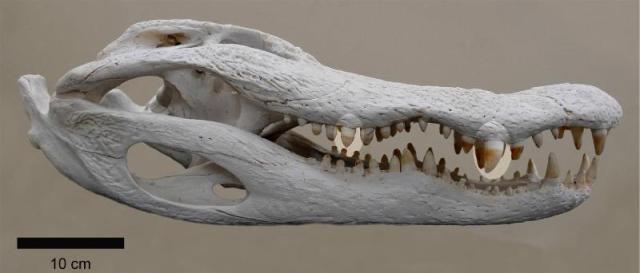Saw this the other day and just flipped out.
Isn’t this the cutest little thing ever??
Just when you thought March, 2013, had given us so many new science break-throughs…
we give you…
And these are just the discoveries during the week March 10th to the 17th!
Are we living in great times, or what?
Well, as if there was much doubt in any of our minds, but still… it is sometimes up to the geeks and nerdlings over at ScienceDaily.com to confirm the obvious.
As the article sets out, Greg Erickson, a Florida State University biology professor, and along with several colleagues, including Florida State biology professors Scott Steppan and Brian Inouye, and graduate student Paul Gignac have been pondering a particularly painful-sounding question: How hard do alligators and crocodiles bite?
 (All crocodilians have essentially the same musculoskeletal design… just different snouts and teeth. [1])
(All crocodilians have essentially the same musculoskeletal design… just different snouts and teeth. [1])
“The answer is a bite force value of 3,700 pounds for a 17-foot saltwater crocodile (as well as tooth pressures of 350,000 pounds per square inch). That’s the highest bite force ever recorded — beating a 2,980-pound value for a 13-foot wild American alligator Erickson’s lab measured in 2005. They estimate that the largest extinct crocodilians, 35- to 40-foot animals, bit at forces as high as 23,100 pounds.”
Erickson and his colleagues reported their findings in the journal PLoS One.
Over the 11 years that his current study took place in both the United States and Australia, Erickson and his team roped 83 adult alligators and crocodiles, strapped them down, placed a bite-force device between their back teeth and recorded the bite force. An engineering calculation was then used to estimate the force generated simultaneously by the teeth nearest the front of the jaws. The team molded the teeth with dentist’s dental putty, made casts and figured out the contact areas.
Now, I know what you’re thinking… or at least I know what I was thinking when I read the article. “These guys are nuts!”
As Erickson describes it: “I have to admit, the first time I placed our meter into the maw of an adult crocodile, I was nervous. It was all over in the blink of an eye. When it struck, it nearly wrested my grip from the handle. The noise of the jaws coming together was like a gunshot. The power of the animal was astounding, and the violence of the event frightening.”
“If you can bench-press a pickup truck, then you can escape a croc’s jaws,” Erickson warned. “It is a one-way street between the teeth and stomach of a large croc.”
Yeah, nuttiness confirmed, all right.
Thank goodness for such adventuresome science nerds. Without them, our world would be a less rich, less fact-filled place.
 ____________________________________________________________
____________________________________________________________
[1] Credit: Image courtesy of Florida State University.
I think Xmas is beginning to corrupt even the most die-hard herpetologists.
Cuteness is everywhere. Even the pages of this blog are not immune. [1]
So it was with a sick fascination that I caught this title in the otherwise non-cute-infected site, ScienceDaily.com…
World’s Smallest Frogs Discovered in New Guinea!
 [Paedophryne dekot (A) and (B), and P. verrucosa (C), and (D), shown several times their actual size]
[Paedophryne dekot (A) and (B), and P. verrucosa (C), and (D), shown several times their actual size]
The article states, “Field work… has found the world’s smallest frogs in southeastern New Guinea. This also makes them the world’s smallest tetrapods (non-fish vertebrates). The frogs belong to the genus Paedophryne, all of whose species are extremely small, with adults of the two new species – named Paedophryne dekot andPaedophryne verrucosa – only 8-9 mm in length.” The study was published in the open access journal ZooKeys.
By the way… 9 mm in length is a bit less than three-eighths of an inch to you pre-metric types out there.
The genus still represents the most miniaturized group of tetrapods in the world.
So, the question is… what’s the deal with the frogs being so tiny??
Researcher Fred Kraus from Bishop Museum, Honolulu, author of the study, explains it all for us.
“Miniaturization occurs in many frog genera around the world,” said the author, “but New Guinea seems particularly well represented, with species in seven genera exhibiting the phenomenon. Although most frog genera have only a few diminutive representatives mixed among larger relatives, Paedophryne is unique in that all species are minute.”
The four known species all inhabit small ranges in the mountains of southeastern New Guinea or adjacent, offshore islands. Their closest relatives remain unclear.
 (Paedophryne dekot)
(Paedophryne dekot)
Another quirk of the puny Paedophryne is their more-than-usually tiny fingers and toes… so tiny, in fact, that it doesn’t really allow them to climb well. All miniature members of this genus inhabit leaf litter and the teensy tootsies could be a corollary of the reduced body size required to living in leaf litter and moss. Small frogs often inhabit this kind of environment and may reflect the frogs’ exploitation of novel food sources in that habitat.
Minuscule body size also has another side effect. Unlike regular frogs that lay entire strings and cords of eggs, these diminutive darlings carry only two eggs. It’s not yet known whether both eggs are laid simultaneously or at staged intervals.
Well, there you have it, my little geeks and nerdlings! Your semi-regular doze of cute!
 ___________________________________________________________
___________________________________________________________
[1] Witness Monday’s article on cute orphan sloths!
Original source:
Kraus F (2011) At the lower size limit for tetrapods, two new species of the miniaturized frog genus Paedophryne (Anura, Microhylidae). ZooKeys 154: 71–88. doi: 10.3897/zookeys.154.1963
References:
Kraus, F. (2010) New genus of diminutive microhylid frogs from Papua New Guinea. ZooKeys 48 (2010) : 39-59. doi: 10.3897/zookeys.48.446